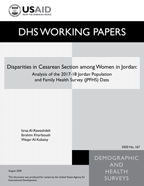There is no printed copy available to order.
Abstract:
Cesarean sections (C sections) are surgical procedures that save maternal and infant lives. In some cases, C sections are done when they are not necessary, while in other cases, some women are unable to access this life-saving intervention. Sociodemographic characteristics are associated with an increased use of C section. Disparities in socioeconomic status and other factors exist in the rates of C sections across diverse populations worldwide. Although C sections are common in Jordan, there is limited evidence about the characteristics associated with C sections. We aim to assess the factors related to the use of C sections and to examine the sociodemographic disparities of these deliveries in Jordan.
We analyzed data from the 2017-18 Jordan Population and Family Health Survey, which is the seventh to be conducted in Jordan. The analysis included a total of 6,525 women age 15-49 who delivered their most recent birth in a health facility in the 5 years before the survey. Statistical analyses used descriptive, bivariate, and logistic regression methods.
The results show that 27% of women were delivered by C sections. C section is significantly associated with older age groups, region, and place of delivery. No significant differences were found by wealth status, place of residence, educational level, employment, nationality, decision making on health, or health insurance. The odds ratio of C section use for women age 40 and over is 3.3 (CI 2.0-5.5), compared to women under age 20. The odds of having a C section is 40% higher for women who delivered in a private hospital compared to women who delivered in a public hospital (CI 1.2-1.8). The odds of C section are 60% lower for women in Aqaba compared to women in Amman (CI 0.3-0.6), and 60% higher for women in Madaba compared to the women in Amman (CI 1.2-2.1).
This study assessed factors related to C section among Jordanian mothers. Our findings highlight the increased practice of C section in the private sector, and suggest the importance of developing national and subnational policies that include clear guidelines for performing C sections, especially in the private sector.
 Disparities in Cesarean Section among Women in Jordan: Analysis of the 2017-18 Jordan Population and Family Health Survey (JPFHS) Data (PDF, 350K)
Disparities in Cesarean Section among Women in Jordan: Analysis of the 2017-18 Jordan Population and Family Health Survey (JPFHS) Data (PDF, 350K)
